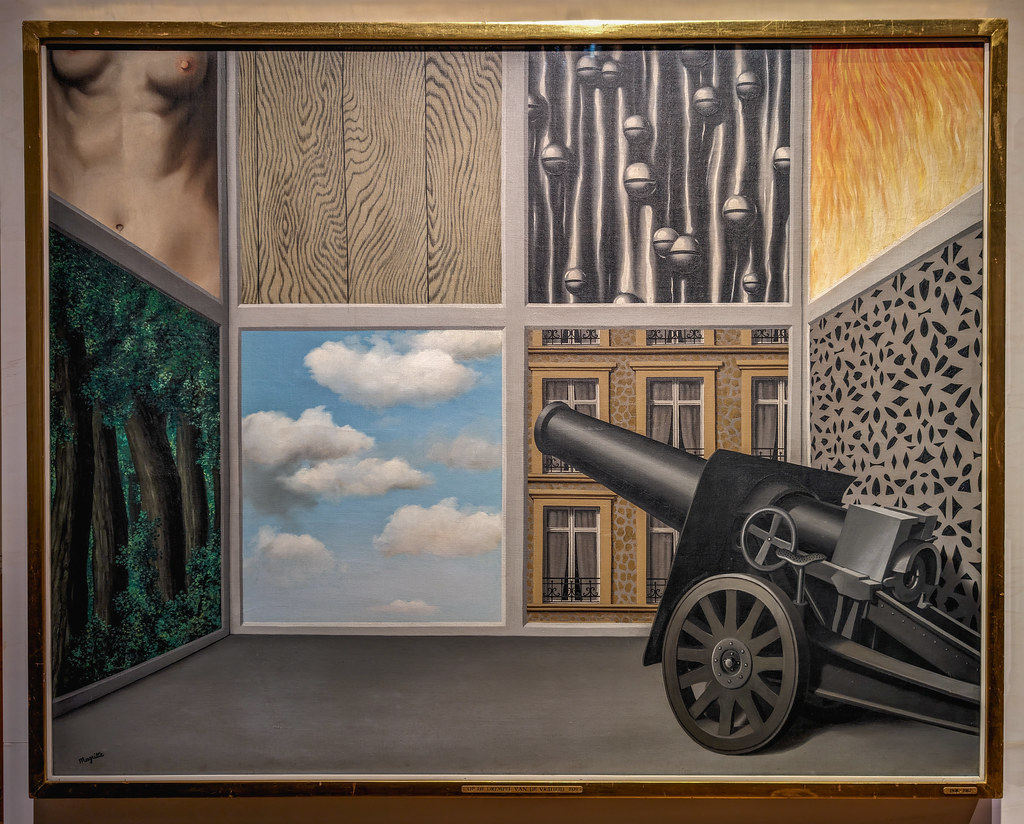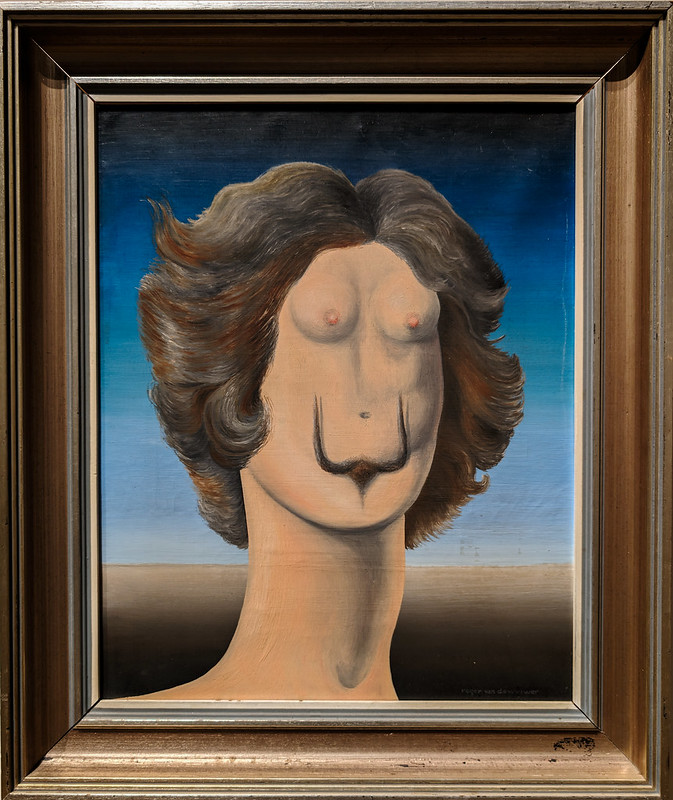Today just opened an all new exhibit celebrating 100 years of Surrealism at the Royal Museums of Fine Arts of Belgium. This immersive experience, which runs until June 16th, delves into the unique trajectory of this artistic movement in Belgium, showcasing its distinct characteristics and its profound impact on the international art scene.
The exhibition boasts an impressive collection of works by iconic Belgian Surrealists, including the likes of René Magritte, Paul Nougé, and Rachel Baes. Each artist is presented through a dedicated section, allowing visitors to appreciate the evolution of their individual styles and thematic explorations. Magritte’s enigmatic dreamlike landscapes, Nougé’s evocative poetry and collages, and Baes’s captivating sculptures and paintings – all come together to paint a vibrant picture of the Belgian Surrealist spirit.
Whether you’re a seasoned art aficionado or simply curious about the world of Surrealism, “Histoire de ne pas rire” is an exhibition not to be missed. It offers a comprehensive and engaging exploration of Belgian Surrealism, providing valuable insights into its artistic contributions and its lasting impact on the art world. So, step into the captivating world of Bozar and embark on a journey through the dreams, desires, and subversive humor of Belgian Surrealism.
Below are some of the works of art you will find at the exhibit:
Marcel Mariën was a pivotal figure in the Belgian Surrealist movement. He was a poet, writer, essayist, photographer, filmmaker, and creator of strange objects and collages. A relentless provocateur, his work was marked by subversive humor, a critique of societal norms, and a fascination with the unexpected.
Bicycles became a recurring theme in Marcel Mariën’s work for several reasons, The bicycle’s inherent absurdity was inherently appealing to Mariën’s sense of humor. It allowed him to playfully dismantle expectations and poke fun at societal conventions. Bicycles were also a way for Mariën to defy the traditional artistic hierarchy. By incorporating an everyday object into his work, he challenges notions of what qualifies as high art.
Magritte’s “The Rape” is a hauntingly provocative image. It depicts a woman’s face, but where her features should be, viewers see a naked female torso. This disturbing juxtaposition of the face with sexualized body parts forces a confrontation with themes of objectification and violence against women.
The painting challenges traditional notions of beauty and the female form. It could represent the way society reduces women to their bodies or the internalized fragmentation of female identity under the male gaze. Magritte may also be referencing his mother’s suicide, connecting the violence of her death with a broader societal violence towards women.
Magritte’s “On the Threshold of Freedom” presents a room with a puzzling twist. Instead of walls, each panel offers a glimpse of a different scene: clouds, fire, wood, a torso, and more. In the center, a powerful cannon points directly at the viewer. This unsettling juxtaposition of familiar and impossible elements creates a sense of wonder and unease.
The painting invites multiple interpretations. It could symbolize the potential for violence lurking beneath the surface of normalcy. The fragmented scenes might represent the limitations of perception or the unattainable nature of true freedom. Ultimately, Magritte’s work challenges our assumptions about reality and encourages viewers to question the boundaries of the possible.

Natural Harmomies by Jane Graverol (1956)
Jane Graverol (1905-1984) was a key figure in the Belgian Surrealist movement, though often overshadowed by her male contemporaries. Her dreamlike paintings delve into a distinctively feminine world, exploring themes of identity, transformation, and the power of the subconscious. Graverol’s work often features enigmatic female figures, animals, and hybrid creatures in uncanny settings, suggesting a fascination with metamorphosis, hidden desires, and the fluidity of the self.
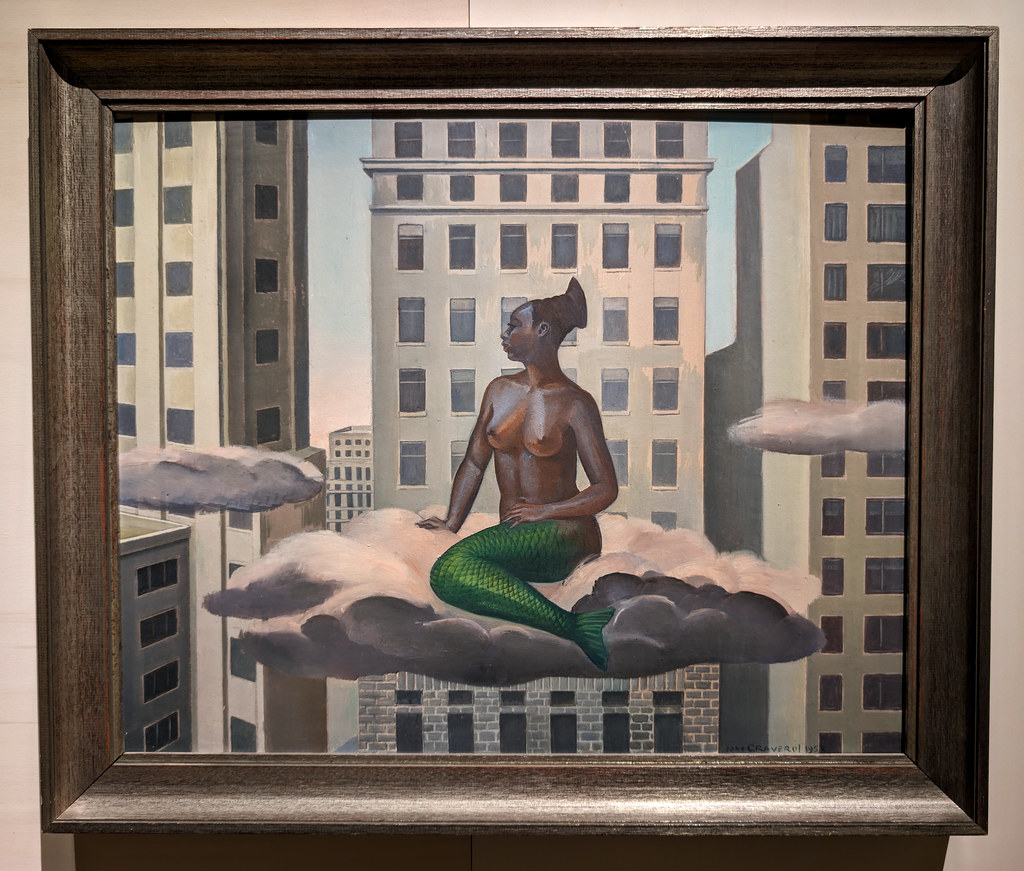
Unknown Africa by Jane Graverol (1956)
Characteristics of the work of Jane Graverol:
Her art draws inspiration from mythology, psychoanalysis, and her own dreams, creating a deeply personal and often unsettling exploration of the female experience. Graverol’s legacy lies in her unique contribution to Surrealism, offering a powerful and evocative vision of the complexities of female identity and the depths of the unconscious mind.
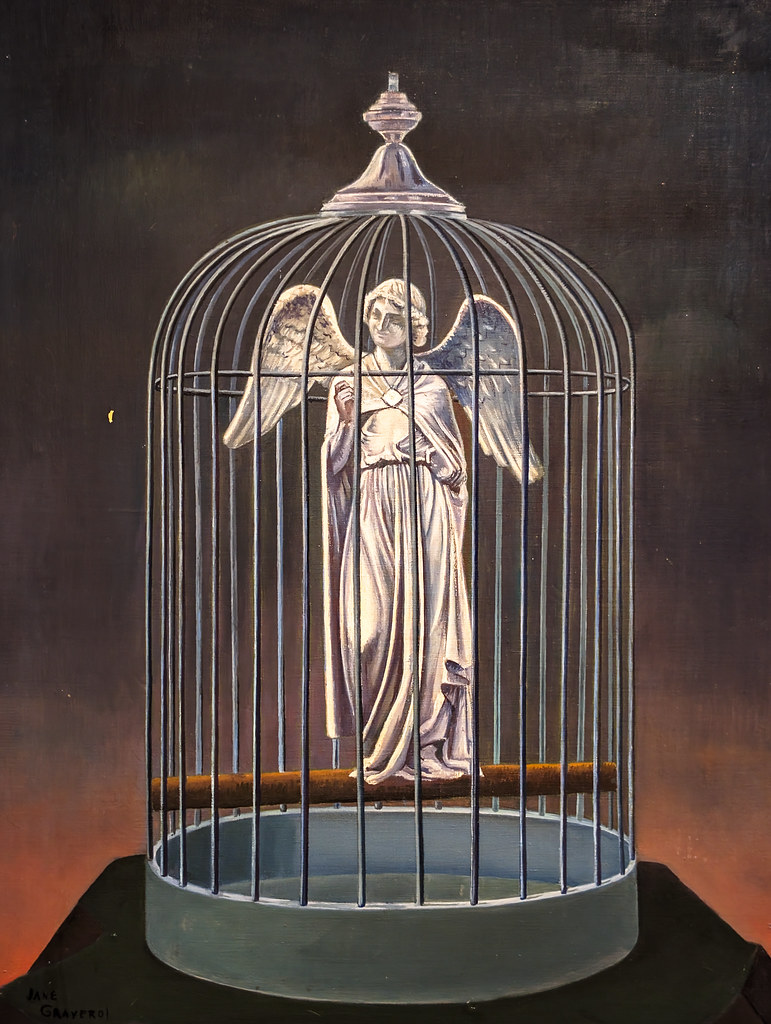
Jane Graverol’s “The Celestial Prison” presents a haunting and enigmatic image that draws the viewer into a world of symbolism and feminine power. The central figure, a woman, is depicted with celestial features. The title suggests a sense of confinement, yet the figure’s direct gaze and celestial body hint at a transformative and powerful force.
The painting could explore themes of identity, captivity, and the cosmic potential within women. The celestial imagery might symbolize the woman’s connection to a larger universe, transcending earthly limitations. Alternatively, it could represent the feeling of being trapped by societal expectations or one’s own internal world. Graverol’s work often invites multiple interpretations, leaving room for viewers to project their own experiences onto the potent symbolism.

The Double Secret by René Magritte (1927)
In René Magritte’s “The Double Secret,” the familiar form of a human torso is shockingly disrupted. The skin is replaced by a cluster of metallic bells, suggesting a hidden complexity or disturbing inner world. This jarring image, set against a serene seascape, forces the viewer to question what lies beneath the surface of appearances and the nature of identity itself.
The title, “The Double Secret,” further deepens the mystery. It could refer to the secrets hidden within the fragmented figure, the unknowable nature of an individual’s inner self, or perhaps the larger secrets of existence that remain obscured from view. Magritte’s work challenges our perceptions of reality, inviting us to look beyond surface appearances and embrace the enigmatic nature of the world around us.
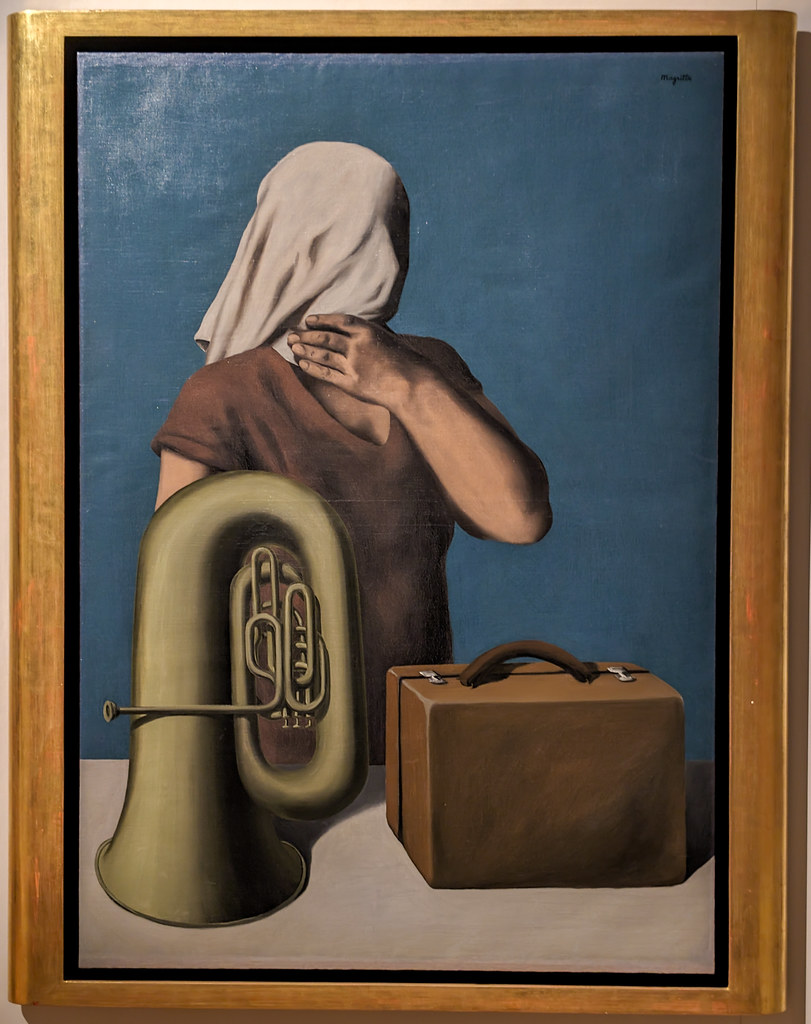
The central story by Rene Magritte (1928)
René Magritte’s “The Central Story” presents a haunting image: a woman’s face obscured by flowing white cloth, surrounded by seemingly random objects like a suitcase and a tuba. This unsettling composition evokes a sense of mystery, hidden pain, and fragmented memory.
The veiled figure is often interpreted as representing Magritte’s mother, who tragically drowned when he was 14. The cloth could symbolize her burial shroud, suggesting unresolved grief. The disjointed objects might represent scattered memories or the inability to fully comprehend the past. Ultimately, the painting questions our ability to truly know another person’s inner life and explores the unsettling power of what remains hidden.
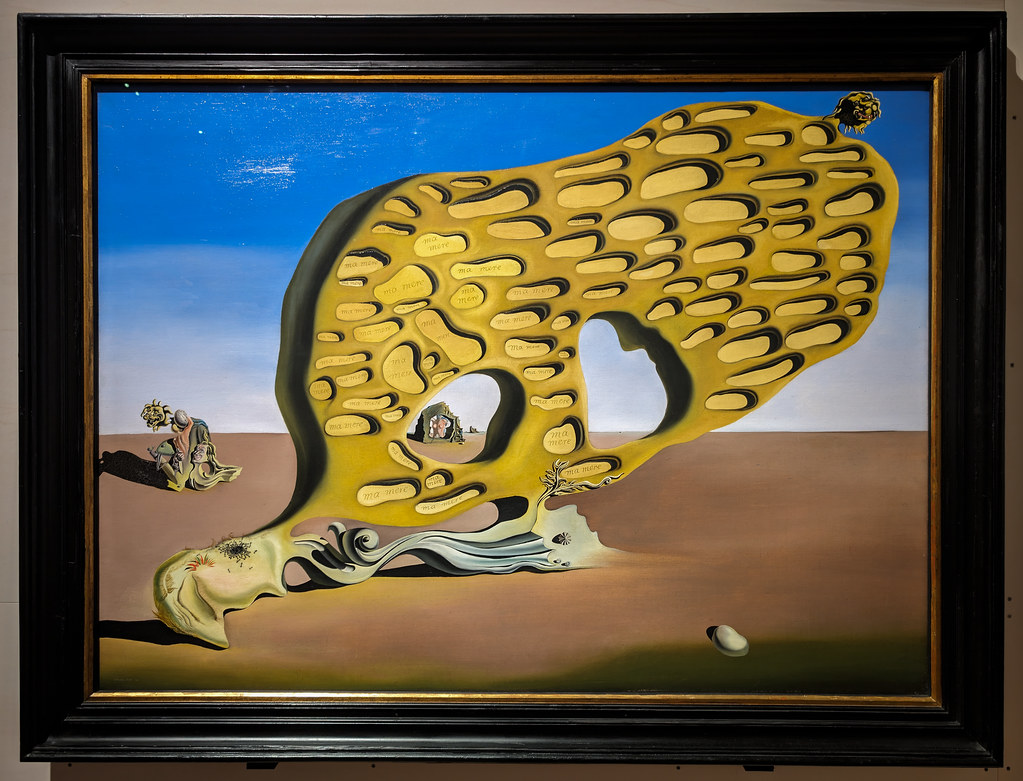
The Enigma of Desire by Salvador Dalí (1929)
Dalí’s “The Enigma of Desire” is a profoundly disturbing dreamscape. A grotesque, decaying figure dominates the foreground, swarming with ants and juxtaposed with a desolate landscape. A shocking inscription reveals violent feelings towards his mother. This unsettling image embodies Dalí’s Oedipal desires, his complex relationship with his mother, and the influence of Freudian psychoanalysis on his work.
The painting forces viewers to confront repressed desires, childhood trauma, and the disturbing power of the subconscious. Its symbolism, including the decaying flesh, ants, and desolate landscape, suggests a profound ambivalence towards the mother figure and a confrontation with the darker aspects of the human psyche.

Magritte’s “The Listening Room” confronts viewers with a surreal and unsettling image. A giant, green apple completely fills the interior of an otherwise ordinary room. This juxtaposition of the familiar and the impossibly large disrupts our sense of scale and reality. The painting invites questions about how we perceive our surroundings and the potential for the extraordinary within the mundane.
The oversized apple could symbolize many things: the dominance of nature, the absurdity of existence, or perhaps a hidden desire or secret lurking beneath the surface of everyday life. Like much of Magritte’s work, “The Listening Room” encourages us to look beyond the obvious and to consider the mysteries that lie just below the surface of the world around us.

Memory by René Magritte (1948)
Magritte’s “Memory” presents a striking and unsettling image. A classical female bust, starkly white, bears a bloody wound on its forehead. This violent injury contrasts sharply with the statue’s serene beauty, creating a sense of profound disturbance. The painting forces viewers to confront themes of violence, memory, and the vulnerability of the idealized form.
The significance of the bloody wound is open to interpretation. It could represent the enduring trauma of past violence, perhaps hinting at the lingering memories of war. Alternatively, it might symbolize the shattering of idealized beauty or perfection, revealing a hidden darkness beneath the surface. Magritte challenges us to reexamine our assumptions about familiar forms and recognize the potential for violence and pain that always lurks beneath the surface.
Roger Van de Wouwer (1933-2005) was a Belgian painter and illustrator whose work is firmly rooted in the Surrealist tradition. Known for his vivid colors, dreamlike imagery, and provocative juxtapositions, Van de Wouwer explored themes of sexuality, identity, and the subconscious.
His work often explores sexuality in a playful and sometimes confrontational manner, pushing boundaries and challenging taboos. Social Critique: Embedded within his works is a sense of rebellion against societal norms and a questioning of conventional values.

The Pink bows by Paul Delvaux (1937)
Paul Delvaux’s “The Pink Bows” is a haunting and enigmatic masterpiece of Belgian Surrealism. The painting depicts a scene of nude or semi-clothed women, some with pink bows set in a classically inspired architectural space. The figures appear detached and somnambulant, creating a sense of dream-like unease.
The painting invites numerous interpretations. The pink bows might represent innocence, femininity, or childishness in stark contrast with the women’s nudity, suggesting a disruption of social expectations. The architectural setting and the figures’ blank expressions could symbolize the confines of societal norms or the disconnect between inner desires and outward appearances. Like much of Delvaux’s work, “The Pink Bows” disturbs and provokes, forcing viewers to question their perceptions of beauty, the female form, and the hidden desires that lie beneath the surface of our world.

Rachel Baes the Philosophy Lesson (1963)
Rachel Baes was a significant figure in Belgian Surrealism, though often overshadowed by her male peers. Her sculptures, paintings, and hybrid objects offer a haunting and deeply personal exploration of the female experience within a patriarchal world. Recurring motifs include dolls, fragmented bodies, and caged figures, suggesting themes of societal constraints, childhood trauma, and the struggle for identity.
Baes’s work often confronts viewers with a sense of psychological unease. Her distorted forms and disturbing imagery expose the hidden anxieties and vulnerabilities that lie beneath the surface of appearances. Through her art, Baes challenges societal norms and offers a powerful indictment of the ways in which women are objectified and confined.
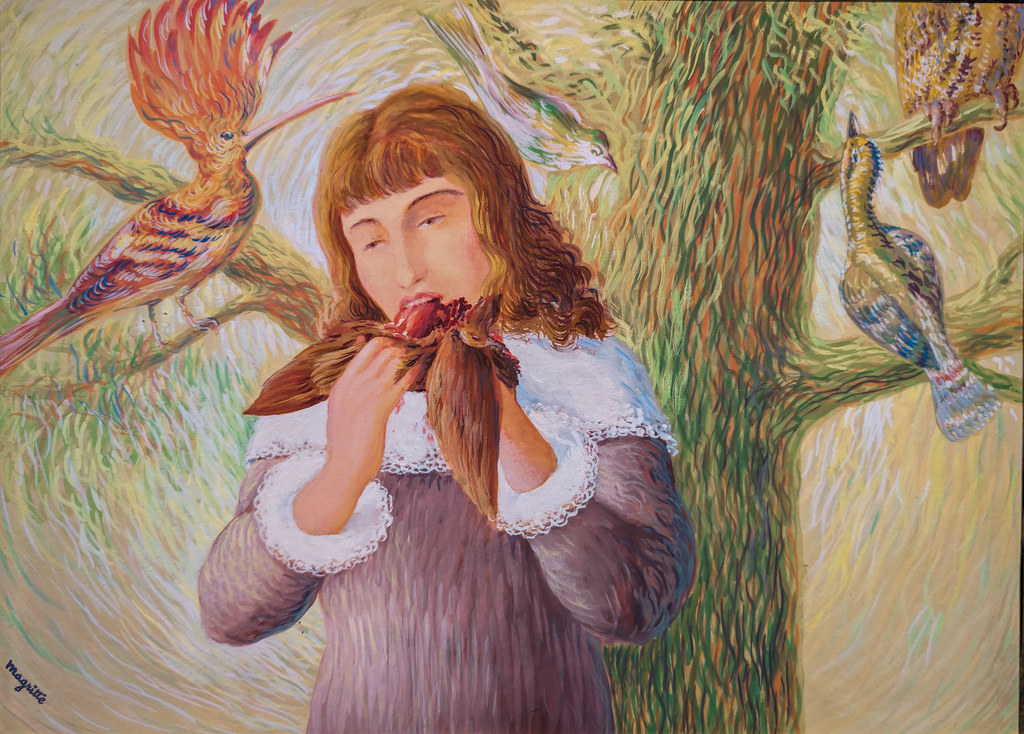
Pleasure by René Magritte (1946)
Rene Magritte’s inspiration often came from the mundane turned bizarre. The story goes that seeing his wife eat a chocolate bird sparked his painting “Pleasure.” This depicts a woman consuming a live bird, a shocking twist that reveals the potential darkness lurking within the ordinary. Magritte chose not to use his wife Georgette’s likeness, perhaps softening the disturbing nature of the scene. A poem by Paul Nougé, written around the same time, adds even more intrigue to the artwork.

In memoriam Mack Sennett by René Magritte
Magritte’s “In Memoriam Mack Sennett” (1936) offers a playful yet haunting tribute to the silent film comedian. In this work, a slightly disheveled woman’s evening gown incongruously spills from an ordinary wardrobe. The absurdity of the image evokes the slapstick humor Sennett became known for.
The painting holds deeper layers. The open wardrobe could hint at hidden desires or the way we construct our public personas. The spilling dress might symbolize the fleeting nature of fame or a vulnerability beneath the surface of appearances. Typical of Magritte, the image sparks a multitude of questions about identity, performance, and the boundary between reality and illusion.




